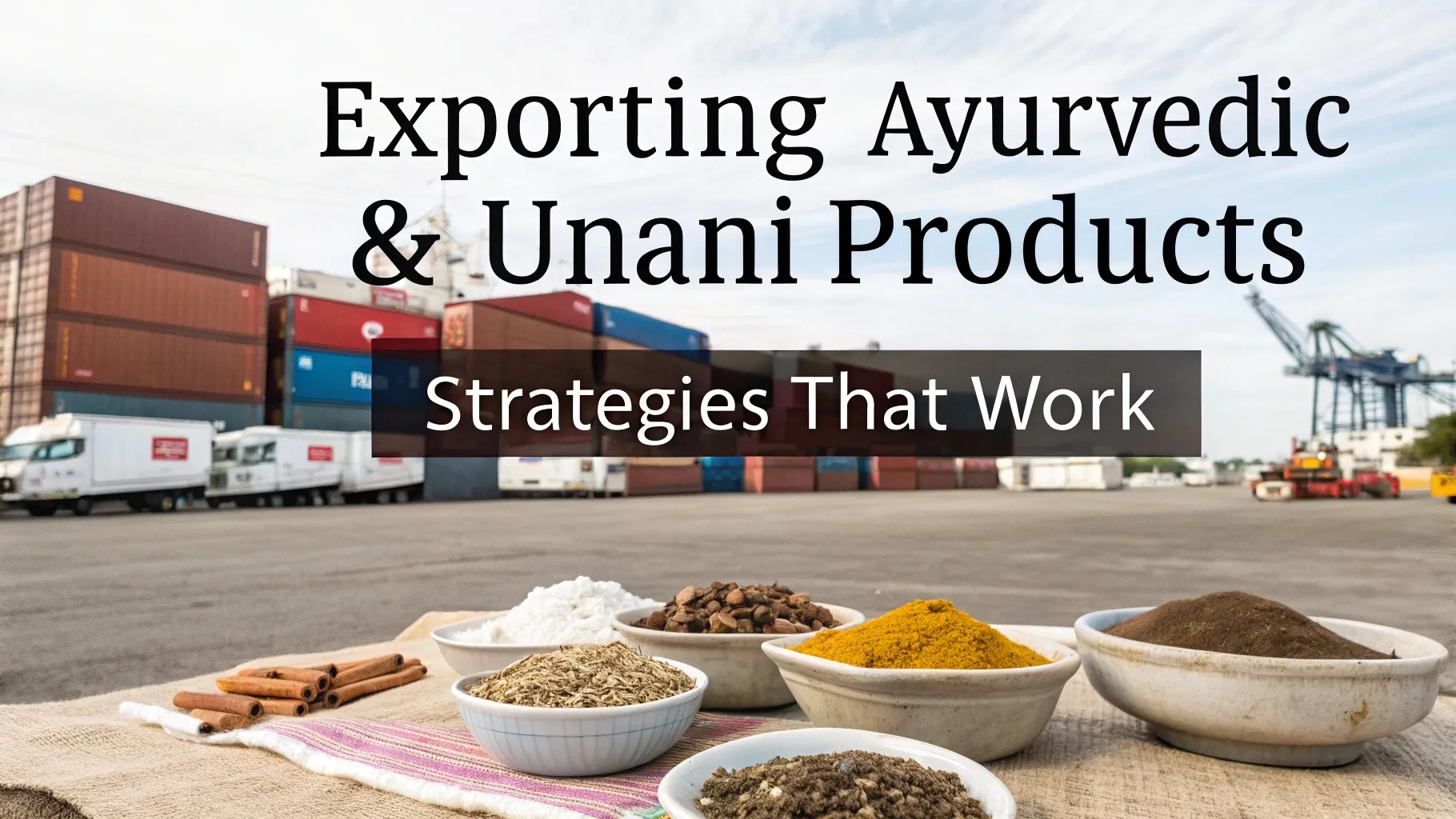The Global Ayurvedic & Unani Market Landscape
People everywhere are turning to natural, plant-based health products, and experts say the herbal-supplement business could hit over $430 billion by 2032, growing at about 7.2% a year. India, home to centuries-old Export Ayurvedic Products , stands out in this wave. Years of herbal knowledge, now backed by lab tests and consistent quality, make Indian formulas popular on almost every continent.
Why India Leads This Surge:
- A worldwide move toward natural and preventive health care.
- Growing interest in the benefits of Ayurveda and Unani treatments.
- Helpful export rules and incentives from AYUSHEXCIL and DGFT.
Top Export Markets Include:
| Country | Estimated Import (INR) | Product Focus |
| USA | ?1,520 crore | Supplements, Herbal Oils |
| Germany | ?522 crore | Homeopathy, Oils, Capsules |
| UAE | ?378 crore | Skin Care, Herbal Blends |
| UK | ?320 crore | Powders, Teas, Tinctures |
With the right tips and tools, Indian businesses can quickly meet rising demand around the world.
What Makes the Handbook So Critical for Exporters
The Handbook on Ayurvedic & Unani Medicines is more than just reading material; it is your day-to-day guide in the export game.
Why It’s a Must-Have:
- Detailed Formulae – More than 100 time-tested recipes show every herb, weight, and step.
- Process Standardization – Step-by-step notes explain how to make, pack, store, and test each item.
- Application-Specific Guidance – Clear notes show how each product supports immunity, digestion, stress relief, or glowing skin.
- Regulatory Compatibility – Most batches meet GMP, ISO, and FSSAI rules, so signing export papers is faster.
Having this handbook on your desk gives you both the know-how to create quality goods and the confidence to sell them abroad.
Grab your copy today and kick off your Ayurvedic brand
What to Export Ayurvedic Products
The book splits products by traditional use and modern form, making it easier to pick what to launch first.
Top Product Picks:
- Ayurvedic Powders (Churna) – Lightweight, stay fresh for years, and fit neatly into any shipment.
Popular Product Segments for Exporters:
- Oils (Taila) – Still a go-to choice for both healing and beauty routines.
- Herbal Tablets & Capsules – Easy to pack, shelf-stable, and stress-free for dosage.
- Cosmetics & Skincare – Face masks, creams, and oils are catching global attention fast.
By picking long-lasting products that shoppers actively seek, exporters can cut risks and boost returns.
Related: Ayurvedic Medicine Business: Step by Step Startup Guide
Legal and Regulatory Requirements for Exporting
Ayurvedic and Unani goods usually count as natural health products abroad, and each nation sets its own rules.
Basic Indian Requirements:
- IEC (Import-Export Code) from DGFT
- AYUSH Manufacturing License
- FSSAI Clearance (for anything people eat or drink)
- GMP and ISO Certification
- Free Sale Certificate from the State Drug Authority
Country-Specific Regulations:
- USA – FDA-friendly labels and safe ingredients
- Europe – EMA rules plus a check for banned items
- GCC – Halal proof and certificates showing where it comes from
The Handbook includes ingredient profiles and process notes, making paperwork and safety clear.
Setting Up Manufacturing: In-House vs. OEM
New brands basically face two paths:
In-House Production:
- Full control over every jar and bottle
- Works best if you already have space and equipment
- The Handbook shares ready-to-apply SOPs to get started
Third-Party (OEM) Manufacturing:
- Smaller budget and faster launch
- Just pick a certified GMP or AYUSH plant
Use Handbook formulas to guide your OEM partner. Doing so keeps every batch original and consistent—even outsourced items still feel authentic and hit export quality marks.
Related: Unlock the Secrets of Herbal Medicine: Mastering Ayurveda & Unani
Pricing, Branding & Product Positioning
Moving herbs overseas is as much about image as it is about the plants themselves.
Brand Tips:
- Highlight Proven Formulas – State that each blend comes from the Handbook on Ayurvedic & Unani Medicines. That detail lends real authority.
- Communicate Benefits Clearly – Use phrases like “Supports immunity,” “Enhances digestion,” and “Promotes restful sleep.”
- Clean, Eco-Conscious Branding – Plant-based inks, recyclable pouches, and simple artwork appeal to shoppers who care about the planet.
Ayurvedic supplements with strong branding often sell for 3× the manufacturing cost abroad, especially when the recipe is backed by the Handbook.
Check our projects for more brief information
Marketing Strategies That Work
Exporting is not only about moving boxes—it’s also about clever, patient marketing.
Promotion Ideas:
- Amazon Global & Etsy – Set up listings with stories that link each product to ancient wisdom
- Wellness Influencers – Send samples to bloggers and vloggers who can show how natural healing works
- Webinars & eBooks – Host online talks and free guides that explain Ayurvedic herbs using data from the Handbook
- Trade Shows & B2B Portals – Exhibit at fairs and list on platforms like Alibaba to meet importers and lock in bulk orders
Logistics, Packaging & Shelf Stability
Choose products with a shelf life of 12 to 24 months. Herbal powders (churna), capsules, and oils usually fit that timeline quite well.
Practical Preservation Steps:
- Moisture-Hardy Packaging – Seal each batch in vacuum pouches or use solid HDPE bottles that resist humidity
- Clear Batch Codes and Labels – Every container should show dosage, the date it was made, and a contact number
- Complete Export Docs – Keep a bill of lading, Certificate of Analysis (CoA), MSDS, and any required phytosanitary papers handy
The Handbook’s full chapters on shelf life and storage still serve as the best step-by-step guide.
Challenges to Watch For (and How to Overcome Them)
The export prize is huge, but hurdles still pop up:
Common Challenges:
- Complex Rules – Pair your team with agencies that update permits following the Handbook whenever laws change
- Product Rejections – Stick to Good Manufacturing Practices, and screen for heavy metals and germs before shipping
- Labeling Blunders – Tailor each label so it meets the law where the product will land, down to font size
- Cultural Fit – Use translated names, and switch to local measures like ounces, milliliters, or grams
Scaling for Long-Term Success
Smart Scaling Moves:
- Build a Product Range – Offering 10 to 15 SKUs raises brand visibility and gives stores more choices
- Line Up Local Partners – A reliable distributor gets fast-moving herbal goods into shelves quickly
- Guard Your Brand Globally – Register trademarks overseas to keep rivals from borrowing your identity
- Keep Innovating – Use the Handbook to test new formulas often, staying fresh and one step ahead of trends
Conclusion: Use the Handbook to Stay Ahead of the Market
Building a strong export business for Ayurvedic and Unani products takes more than big dreams—it takes a clear plan.
The Handbook on Ayurvedic and Unani Medicines with Formulae, Processes and Their Uses gives you that plan.
Packed with over 100 standardized recipes, step-by-step processing notes, and real-world use tips, it turns your idea into a brand people around the world trust.
Whether you’re launching your first product or growing a larger factory, this book helps you deliver quality, meet rules, earn respect, and most important—boost profits.






